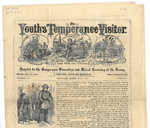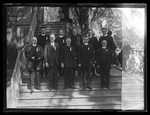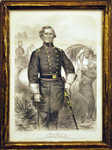Keywords: Temperance Movement
- Historical Items (71)
- Tax Records (0)
- Architecture & Landscape (0)
- Online Exhibits (21)
- Site Pages (4)
- My Maine Stories (0)
- Lesson Plans (2)
Online Exhibits
Your results include these online exhibits. You also can view all of the site's exhibits, view a timeline of selected events in Maine History, and learn how to create your own exhibit. See featured exhibits or create your own exhibit
Exhibit
Rum, Riot, and Reform - Temperance Membership
"Some were independent, while others linked to national and state movements or organizations. X Youth's Temperance Ribbon Silk Late 19th…"
Exhibit
Rum, Riot, and Reform - Women Leaders and Temperance
"GALLERIES: Politics and Enforcement | Women Leaders and Temperance | Quenching the Thirst | Business as Usual"
Exhibit
Rum, Riot, and Reform - 1820 to 1865: Temperance and the Maine Law
"Groups like the Temperance Watchman of Durham, Maine, one of the first formed in 1848, strove to set a moral example and achieve social control…"
Exhibit
Throughout the history of the state, residents have protested, on paper or in the streets, to increase rights for various groups, to effect social change, to prevent social change, or to let their feelings be known about important issues.
Exhibit
Prohibition in Maine in the 1920s
Federal Prohibition took hold of America in 1920 with the passing of the Volstead Act that banned the sale and consumption of all alcohol in the US. However, Maine had the Temperance movement long before anyone was prohibited from taking part in one of America's most popular past times. Starting in 1851, the struggles between the "drys" and the "wets" of Maine lasted for 82 years, a period of time that was everything but dry and rife with nothing but illegal activity.
Exhibit
Begin Again: reckoning with intolerance in Maine
BEGIN AGAIN explores Maine's historic role, going back 528 years, in crisis that brought about the pandemic, social and economic inequities, and the Black Lives Matter movement in 2020.
Exhibit
While numerous Mainers worked for and against woman suffrage in the state in the late nineteenth and early twentieth centuries, some also worked on the national level, seeking a federal amendment to allow women the right to vote
Exhibit
Rum, Riot, and Reform - The Continuing Debate
"… positive change emerged from the ranks of the temperance movements—the dramatic and lasting drop in the amount of liquor Americans consumed."
Exhibit
Maine's Untold Vegetarian History
Vegetarianism has deep roots in Maine and this first-of-its-kind exhibition explores this untold story.
Exhibit
Rum, Riot, and Reform - Overview & Introduction
"Temperance and prohibition movements, like the fight to abolish slavery and the struggle for women's suffrage, engaged the nation's full attention."
Exhibit
Rum, Riot, and Reform - Reform and Repeal
"1920 Collections of Maine Historical Society/Maine Today Media Coll. 1949; 2005.061.13657 These temperate citizens on a parade review stand in…"
Exhibit
Rum, Riot, and Reform - Neal Dow
"GALLERIES: A Call to Temperance | Temperance Membership | Neal Dow | Drinking: Elegance and Debauchery"
Exhibit
Rum, Riot, and Reform - 1865 to 1919: The Drys Gain New Adherents and Leaders
"… and Democratic politicians, built a power base on temperance success. Mainers contributed to this national reform through numerous leaders…"
Exhibit
Rum, Riot, and Reform - Politics and Enforcement
"… Historical Society Francis Murphy gave his first temperance lecture in Portland on April 3, 1870 and soon became a powerful voice."
Exhibit
Rum, Riot, and Reform - Society Copes
"… culture from the state that led the nations temperance movements. X The Alcoholic Blues , 1919 Broadway Music Corporation Collections of…"
Exhibit
The National Federation of Business and Professional Women's Clubs (NFBPWC) held their seventh annual convention in Portland during July 12 to July 18, 1925. Over 2,000 working women from around the country visited the city.
Exhibit
Success at riding a bike mirrored success in life. Bicycling could bring families together. Bicycling was good for one's health. Bicycling was fun. Bicycles could go fast. Such were some of the arguments made to induce many thousands of people around Maine and the nation to take up the new pastime at the end of the nineteenth century.
Exhibit
Dressing Up, Standing Out, Fitting In
Adorning oneself to look one's "best" has varied over time, gender, economic class, and by event. Adornments suggest one's sense of identity and one's intent to stand out or fit in.
Exhibit
John Y. Merrill: Leeds Farmer, Entrepreneur, & More
John Y. Merrill of Leeds (1823-1898) made terse entries in diaries he kept for 11 years. His few words still provide a glimpse into the life of a mid 18th century farmer, who also made shoes, quarried stone, moved barns, made healing salves -- and was active in civic affairs.
Exhibit
Longfellow: The Man Who Invented America
Henry Wadsworth Longfellow was a man and a poet of New England conscience. He was influenced by his ancestry and his Portland boyhood home and experience.
Exhibit
The history of the region now known as Maine did not begin at statehood in 1820. What was Maine before it was a state? How did Maine separate from Massachusetts? How has the Maine we experience today been shaped by thousands of years of history?





















